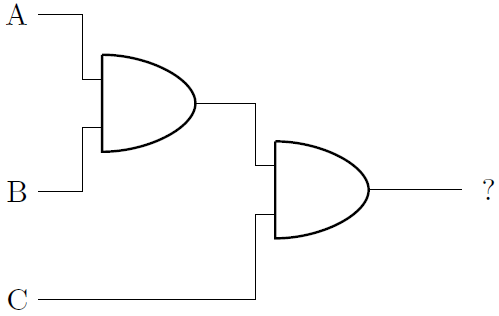Boolean Algebra
As the name suggests, Boolean algebra is algebra of 0 and 1, or FALSE and TRUE.
Basic Operations
▪ AND \((x\wedge y)\) is 1 if both \(x\) and \(y\) are 1, otherwise 0. It is also known as conjunction. (In more intuitive terms, A AND B is true only if both A and B are true.)
▪ OR \((x\vee y)\) is 0 if both \(x\) and \(y\) are 0, otherwise 1. (This is an "inclusive or". In other words, A OR B is true if one or the other or both are true.)
▪ NOT \((\sim x)\) is 0 if \(x\) is 1, and 1 if \(x\) is 0. (This simply flips from true to false, so NOT true is false, and NOT false is true.
Which of the following results true for \(x=y=0\), \(a=b=1\)?
Truth Tables
A truth table is a table which gives input and output of an operator for different values of \(x\) and \(y.\)
Truth table for AND: \(\begin{array} {| c | c | c | c |} \hline x & y & x\wedge y \\ \hline 0 & 0 & 0\\ \hline 0 & 1 & 0\\ \hline 1 & 0 & 0\\ \hline 1 & 1 & 1\\ \hline \end{array}\)
Truth table for OR: \(\begin{array} {| c | c | c | c |} \hline x & y & x\vee y \\ \hline 0 & 0 & 0\\ \hline 0 & 1 & 1\\ \hline 1 & 0 & 1\\ \hline 1 & 1 & 1\\ \hline \end{array}\)
Truth table for NOT: \(\begin{array} {| c | c | c | c |} \hline x & ~x \\ \hline 0 & 1\\ \hline 1 & 0\\ \hline \end{array}\)
Draw the truth table for \(\sim (x\vee y)\).
\(\sim (x\vee y)\) implies NOT \(x\vee y\).
So we will first draw the table for \(x\vee y,\) and then reverse the final outputs in the end.
\(\begin{array} {| c | c | c | c |} \hline x & y & x\vee y & \sim (x\vee y) \\ \hline 0 & 0 & 0& 1\\ \hline 0 & 1 & 1& 0\\ \hline 1 & 0 & 1& 0\\ \hline 1 & 1 & 1& 0\\ \hline \end{array}\)
Laws
Associativity
\(x\vee (y\vee z)=(x\vee y)\vee z\)
\(x\wedge (y\wedge z)=(x\wedge y)\wedge z\)
Commutativity
\(x\vee y=y\vee x\)
\(x\wedge y=y\wedge x\)
Distributivity
\(x\vee (y\wedge z)= (x\vee y)\wedge (x\vee z)\)
\(x\wedge (y\vee z)=(x\wedge y)\vee (x\wedge z)\)
Identity
\(x\vee 0=x\)
\(x\wedge 1=x\)
Annihilator
\(x\vee 1=1\)
\(x\wedge 0=0\)
Idempotence
\(x\vee x=x\)
\(x\wedge x=x\)
Absorption
\(x\vee (x\wedge y)=x\)
\(x\wedge (x\vee y)=x\)
Complementation
\(x\vee \sim x=1\)
\(x\wedge \sim x=0\)
Double negation
- \(\sim (\sim x)=x\)
De Morgan's Laws
\(\sim x\vee \sim y=\sim (x\wedge y)\)
\(\sim x\wedge \sim y=\sim (x\vee y)\)
When is the Boolean expression \((\neg p) \wedge (\neg q)\) true?
The negation of \( \sim s \lor ( \sim r \land s)\) is equivalent to \(\text{__________}.\)
Secondary operators
\( \begin{array} {| c | c | c | c | c |} \hline x & y & x\to y & x \oplus y & x \equiv y \\ \hline 0 & 0 & 1 & 0& 1\\ \hline 1 & 0 & 0 & 1& 0\\ \hline 0 & 1 & 1 & 1& 0\\ \hline 1 & 1 & 1& 0 & 1\\ \hline \end{array}\)
Material implication \(x \to y\) is defined as \(\sim x\vee y\): that is, \(y\) when \(x\) is true and \(x\) when \(x\) is false.
Exclusive Or (XOR) \(x\oplus y\) is defined as \((x\vee y)\wedge \sim (x\wedge y)\).
Equivalence (Boolean equality) \(x\equiv y\) is defined as \(\sim (x\oplus y)\). It is true when \(x\) and \(y\) are equal and false when they are not.
\[\neg \big(\neg (p \implies q) \implies \neg (q \implies p)\big)\]
Which of the given options is equivalent to the above Boolean expression?
Applications
While boolean algebra is used often in coding, it has its most direct application in logic circuits. In a circuit a 0 can be considered a circuit that is OFF and a 1 is a circuit that is ON. AND, OR, and NOT gates each have their own symbol.

The inputs are on the left side of the gate and the outputs are on the right side.

The gates above are "inverters" or "NOT gates", that switch high voltage (1) to low voltage (0) or vice versa. What is the output?

The AND gates in the diagram will output a 1 if both inputs are also 1.
If A = 1, B = 1, and C = 0, what will the final output be?

The setup above works like a XOR gate (the output will be 1 if exactly one of the inputs is 1). However, the gate marked by a blue box is missing. What is the gate?